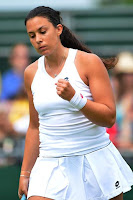 |
| Marion Bartoli |
Logic has created a game in
which all court surfaces have been equalized. Clay, grass, and Deco-Turf have
been engineered to provide uniformly high and true bounces, with precious
little room for idiosyncrasy, as if Microsoft or IBM had been in charge of the
project.
Logic dictates that each
player have nearly identical groundstrokes, hit every topspin forehand as hard
as humanly possible and sometimes even harder. And, logic tells the players to
hold fast to the safety of the baseline.
Consequently, rational
thinking says, “Don’t rush the net; it’s scary up there.” So, we have worn-out
baseline grass at Wimbledon and first-day looking green up near the net, where
past greats made thousands of winning volleys.
Federer, of course, is mostly
exempt from all this, except for fear of net play. His strokes and versatility
are throwbacks to yesteryear and yet, he still hits with enormous power. But, Fed may be fading at last. Hopefully, young players will ignore their coaches and emulate Fed’s style as
much as possible.
Marion Bartoli defies all
this logic, and we must love her for that. First, her apparently lax dietary regimen, to which many of us can closely relate. Then, her quirky service motion
and extra high toss. Her second serve is slower than that of some clubs’ B
–Team members, but she wins 60-70% of points when she makes her first serve.
She is prone to hit two-handed from both sides, even her volleys, and, yes, she
forays into net (Rejoice!). Aside from all that, she is French. Enough said.
Tennis has a huge marketing
advantage, which it hides in plain view. It is the only sport in which men and
women compete side by side in its major championships; only the Olympics does
the same. Thus, we have two-week pageants, rather than four days like The
Masters, and we have the potential of seeing a great variety of playing styles.
Once again at Wimbledon, American men
were nowhere near good enough to challenge in the singles draw. Thank goodness for the remarkable Bryan Brothers in doubles. The young American
women, especially Sloane Stephens, show greater promise, but did not get
beyond
the quarters this year (where Bartoli beat Stephens). Logically, the poobahs of the
USTA have been yearning for and investing in the next American champions in the "inner-city" for
over a decade, one dominated by the Williams sisters, who developed almost
entirely outside the USTA system. How long will that quest take to succeed? A couple of more years for the women perhaps, and much longer for the men, if ever.
 |
| perche du lac |
Marion Bartoli may not ever
repeat her Wimbledon accomplishment and may not ever win another major, but we
all owe her a debt of gratitude for her logic-defying win. We can only hope
that more quirk will sneak into the game, and that the grass courts will once again be
soft, instead of being a kind of fuzzy concrete. We can hope for some odd
bounces, ground strokes that look as if they were forged in isolation with
great creativity; and we can pray that more players will learn the joys of net
play.
Friday’s men’s semi-final
between Djokovic and del Potro is being called one of the great matches, and
much of it was fun to watch. But, it took nearly five hours to complete, a
Tolstoyan epic in a Twitter age and the longest semi in Wimbledon history.
Now, there’s something funky and noble about that too; however, we should remember
that the tie-breaker was put in place largely to shorten men’s matches. But
that was in the serve and volley era on grass and hard courts. What are we
going to do now?
I watched that semi at the club where I play. At the end, one of the three gents watching with me, all in
their eighties, said to his pals, "Not long ago, this place would have been packed to watch a Wimbledon semi on a holiday weekend."
their eighties, said to his pals, "Not long ago, this place would have been packed to watch a Wimbledon semi on a holiday weekend."
The team players march on, as do the pros and the hundreds of free-boat college players, but the everyday players, especially the young ones are disappearing, having chosen other games to play. Perhaps they've come to the logical conclusion that five hours is a bit too long to play a game, even golf.
Sad to say, they may be right about that.

No comments:
Post a Comment